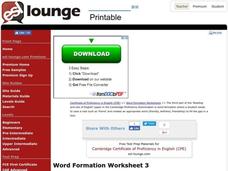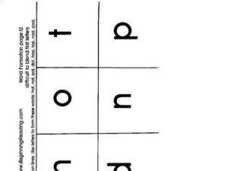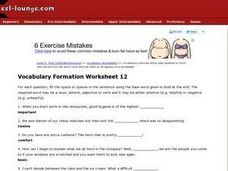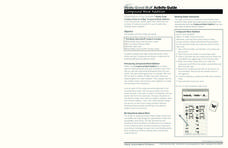Curated OER
Word Formation
In this word formation worksheet, students fill in the spaces in six sentences with the base word given in bold in its correct form.
Curated OER
Word Formation Worksheet 7
In this ESL word formation activity, students read 7 sentences that have a missing word. Students fill the space using the base word given in bold at the end. Prefixes and suffixes may be added.
Curated OER
Word Formation: Word Families
In this word formation worksheet, young scholars identify groups of words that belong to the same word family, create word families from a given word, and fill in sentences using words that come from the same word family. Students answer...
Curated OER
ESL: Advanced/Proficiency Word Formation Worksheet
In this ESL word formation worksheet, students fill in the space or spaces in a sentence using the given base word. They complete 6 sentences.
Curated OER
Word Formation Worksheet 1
In this ESL vocabulary building worksheet, students read 10 sentences that have a missing word. Using the base word provided, students fill in the space with a noun, adverb, adjective or verb that fits the sentence.
Curated OER
Word Formations
In this word formations worksheet, students cut out six letters and rearrange the letters to spell four main words: ran, fan, man and van.
Curated OER
Beginning Reading: Word Formation
In this word formation worksheet, learners cut out the letters f, g, o, l, t and n. Then they use these letters to form the words fog, log, lot and not.
Curated OER
Word Formations (Page 12)
In this word formations worksheet, students cut out and rearrange six letters to form seven key words to learn for mastery: hot, not, pot, top, pod and nod.
Curated OER
Word Formations (Page 5)
For this word formations worksheet, students cut out and rearrange six letters to form four key words to learn for mastery: lip, sip, rip and nip.
Curated OER
Word Formations (Page 6)
In this word formations worksheet, students cut out six letters to rearrange into four key terms to learn for mastery: fix, six, tin and win.
Curated OER
Word Formation #6
For this word formation worksheet, students practice creating new words from base words to place in each blank in ten sentences in order to make each one grammatically correct.
Curated OER
Vocabulary Formation Worksheet 10
In this vocabulary formation worksheet, 5th graders read eight sentences and fill in the blanks in each sentence with an appropriate form of the base word in bold found at the end of each sentence.
Curated OER
Vocabulary Formation Worksheet 11
In this vocabulary formation worksheet, 5th graders read eight sentences and fill in each blank with a new word formed from the base word found at the end of each sentence.
Curated OER
Vocabulary Formation Worksheet 12
In this forming new words worksheet, 5th graders read, interpret and fill in the blanks in each sentence with a new word formed from the base word at the end of each sentence.
Curated OER
Vocabulary Formation Worksheet 21
In this vocabulary formation learning exercise, 5th graders fill in the blanks in eight sentences by forming new words from the word roots at the end of each sentence.
Curated OER
Vocabulary Formation Worksheet 4
In this vocabulary formation worksheet, 5th graders fill in the blank in eight sentences as they form new words from the root words at the end of each sentence.
Curated OER
Vocabulary Formation Worksheet 20
In this vocabulary enrichment worksheet, 5th graders fill in the blanks in eight sentences by forming a new word from the root word at the end of each sentence.
Curated OER
Beginning Reading: Word Formation
For this word formation worksheet, students cut out the following four letters: f, u, n, r, s, t. Students then use these letters to form the following words: fun, run, sun, nut.
Curated OER
Word Formation Worksheet 9
In this ESL spelling worksheet, students will focus on vocabulary enhancement. Students will complete 10 fill in the blank questions, by reading each sentence using the correct form of the given base word to complete each.
Really Good Stuff
Compound Word Addition
Sometimes you can add two words together to make one longer word! Practice doing just this with your class with the worksheets and activities included here. The main goal here is to look at an image, name it, and figure out the two words...
CK-12 Foundation
Square Roots and Irrational Numbers: Estimating Radicals
Try out a resource using triangles to estimate radicals. An interactive app allows learners to approximate some irrational numbers involving square roots. They find the two consecutive numbers that an irrational number lies between by...
CK-12 Foundation
Evaluation of Square Roots
Think outside the box and use an engaging, interactive app that shows the relationship between square roots and squares using an actual square. Pupils find that moving a slider increases the side length of a square and its associated area.
Curated OER
Beyond the Dictionary: Meaningful Word Study
Engaging lesson and activity ideas that grow pupils' word knowledge in all content areas.
Curated OER
APA and MLA Formats: Their Main Differences
What is the difference between MLA and APA format? This presentation is geared towards a college audience, but it could definitely be useful with an eleventh and twelfth grade audience in high school. Differences are highlighted, but not...

























